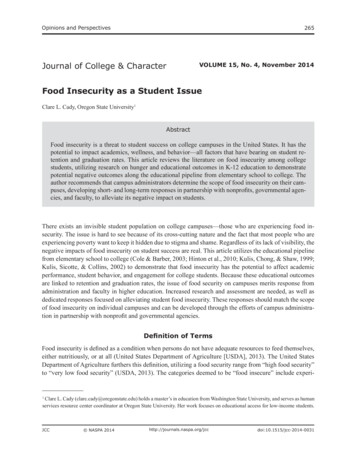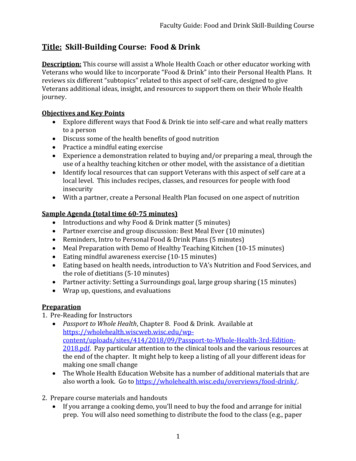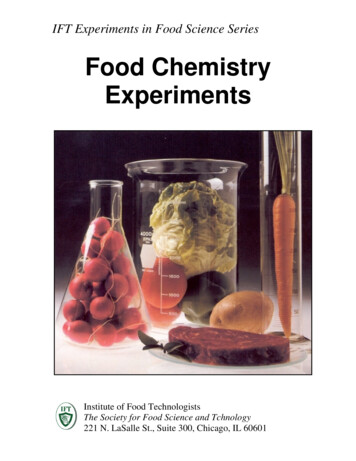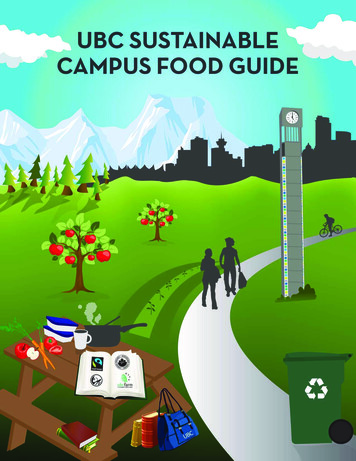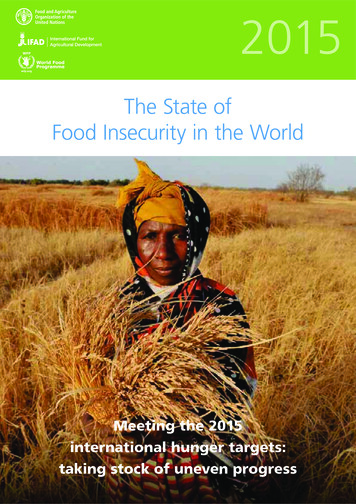
Transcription
2015The State ofFood Insecurity in the WorldMeeting the 2015international hunger targets:taking stock of uneven progress
Cover photo: FAO/Seyllou DialloFAO information products are available on the FAO website (www.fao.org/publications)and can be purchased through publications-sales@fao.org
Key messagesJ About 795 million people are undernourishedwestern Africa, south-eastern Asia andglobally, down 167 million over the lastdecade, and 216 million less than in1990–92. The decline is more pronouncedin developing regions, despite significantSouth America, undernourishment declinedpopulation growth. In recent years, progresshas been hindered by slower and lesswater, particularly for poorer populationgroups.inclusive economic growth as well as politicalinstability in some developing regions,such as Central Africa and western Asia.J The year 2015 marks the end of themonitoring period for the MillenniumDevelopment Goal targets. For thedeveloping regions as a whole, the shareof undernourished people in the totalpopulation has decreased from 23.3 percentin 1990–92 to 12.9 per cent. Some regions,such as Latin America, the east and southeastern regions of Asia, the Caucasus andCentral Asia, and the northern and westernregions of Africa have made fast progress.Progress was also recorded in southern Asia,Oceania, the Caribbean and southern andeastern Africa, but at too slow a pace to reachthe MDG 1c target of halving the proportionof the chronically undernourished.J A total of 72 developing countries out of 129,or more than half the countries monitored,have reached the MDG 1c hunger target.Most enjoyed stable political conditionsand economic growth, often accompaniedby social protection policies targeted atvulnerable population groups.J For the developing regions as a whole, thetwo indicators of MDG 1c – the prevalenceof undernourishment and the proportion ofunderweight children under 5 years of age –have both declined. In some regions, includingfaster than the rate for child underweight,suggesting room for improving the quality ofdiets, hygiene conditions and access to cleanJ Economic growth is a key success factorfor reducing undernourishment, but it hasto be inclusive and provide opportunitiesfor improving the livelihoods of the poor.Enhancing the productivity and incomes ofsmallholder family farmers is key to progress.J Social protection systems have been criticalin fostering progress towards the MDG 1hunger and poverty targets in a numberof developing countries. Social protectiondirectly contributes to the reduction ofpoverty, hunger and malnutrition bypromoting income security and access tobetter nutrition, health care and education.By improving human capacities and mitigatingthe impacts of shocks, social protection fostersthe ability of the poor to participate in growththrough better access to employment.J In many countries that have failed to reachthe international hunger targets, natural andhuman-induced disasters or political instabilityhave resulted in protracted crises withincreased vulnerability and food insecurity oflarge parts of the population. In such contexts,measures to protect vulnerable populationgroups and improve livelihoods have beendifficult to implement or ineffective.
2015The State ofFood Insecurity in the WorldMeeting the 2015international hunger targets:taking stock of uneven progressFOOD AND AGRICULTURE ORGANIZATION OF THE UNITED NATIONSRome, 2015
Required citation:FAO, IFAD and WFP. 2015. The State of Food Insecurity in the World 2015.Meeting the 2015 international hunger targets: taking stock of uneven progress.Rome, FAO.The designations employed and the presentation of material in this information productdo not imply the expression of any opinion whatsoever on the part of the Food andAgriculture Organization of the United Nations (FAO), the International Fund forAgricultural Development (IFAD) or of the World Food Programme (WFP) concerning thelegal or development status of any country, territory, city or area or of its authorities,or concerning the delimitation of its frontiers or boundaries. The mention of specificcompanies or products of manufacturers, whether or not these have been patented,does not imply that these have been endorsed or recommended by FAO, IFAD or WFP inpreference to others of a similar nature that are not mentioned.The designations employed and the presentation of material in the maps do not implythe expression of any opinion whatsoever on the part of FAO, IFAD or WFP concerningthe legal or constitutional status of any country, territory or sea area, or concerning thedelimitation of frontiers.ISBN 978-92-5-108785-5FAO encourages the use, reproduction and dissemination of material in this informationproduct. Except where otherwise indicated, material may be copied, downloaded andprinted for private study, research and teaching purposes, or for use in non-commercialproducts or services, provided that appropriate acknowledgement of FAO as the sourceand copyright holder is given and that FAO’s endorsement of users’ views, products orservices is not implied in any way.All requests for translation and adaptation rights, and for resale and other commercialuse rights should be made via www.fao.org/contact-us/licence-request or addressed tocopyright@fao.org.FAO information products are available on the FAO website (www.fao.org/publications)and can be purchased through publications-sales@fao.org. FAO 2015
6ForewordAcknowledgements8Undernourishment around the world in 20158The global trends10Wide differences persist among regions17Key findingsInside the hunger target:comparing trends in undernourishmentand underweight in children1919Regional patterns25Key findings26Food security and nutrition:the drivers of change27Economic growth and progress towards food security and nutritiontargets31The contribution of family farming and smallholder agricultureto food security33International trade and food security linkages35The relevance of social protection for hunger trends between1990 and 201537Protracted crises and hunger42Key findings44Technical annex44Annex 1: Prevalence of undernourishment and progress towards the WorldFood Summit (WFS) and the Millennium Development Goal (MDG) targetsin developing regions48Annex 2: Methodology for assessing food securityand progress towards the international hunger targets53Annex 3: Glossary of selected terms used in the report54NotesC O N T E N T S4
F O R E W O R D4This year s annual State of Food Insecurity in the World report takes stock of progress madetowards achieving the internationally established hunger targets, and reflects on what needsto be done, as we transition to the new post-2015 Sustainable Development Agenda.United Nations member states have made two major commitments to tackle world hunger.The first was at the World Food Summit (WFS), in Rome in 1996, when 182 governmentscommitted “. to eradicate hunger in all countries, with an immediate view to reducing thenumber of undernourished people to half their present level no later than 2015”. The secondwas the formulation of the First Millennium Development Goal (MDG 1), established in 2000 bythe United Nations members, which includes among its targets “cutting by half the proportion ofpeople who suffer from hunger by 2015”.In this report, we review progress made since 1990 for every country and region as well as forthe world as a whole. First, the good news: overall, the commitment to halve the percentage ofhungry people, that is, to reach the MDG 1c target, has been almost met at the global level.More importantly, 72 of the 129 countries monitored for progress have reached the MDG target,29 of which have also reached the more ambitious WFS goal by at least halving the number ofundernourished people in their populations.Marked differences in progress occur not only among individual countries, but also acrossregions and subregions. The prevalence of hunger has been reduced rapidly in Central, Easternand South-Eastern Asia as well as in Latin America; in Northern Africa, a low level has beenmaintained throughout the MDG and WFS monitoring periods. Other regions, including theCaribbean, Oceania and Western Asia, saw some overall progress, but at a slower pace. In tworegions, Southern Asia and sub-Saharan Africa, progress has been slow overall, despite manysuccess stories at country and subregional levels. In many countries that have achieved modestprogress, factors such as war, civil unrest and the displacement of refugees have often frustratedefforts to reduce hunger, sometimes even raising the ranks of the hungry.Progress towards the MDG 1c target, however, is assessed not only by measuringundernourishment, or hunger, but also by a second indicator – the prevalence of underweightchildren under five years of age. Progress for the two indicators was similar, but slightly faster inthe case of undernourishment. While both indicators have moved in parallel for the world as awhole, they diverge significantly at the regional level owing to the different determinants of childunderweight.Overall progress notwithstanding, hunger remains an everyday challenge for almost795 million people worldwide, including 780 million in the developing regions. Hence, hungereradication should remain a key commitment of decision-makers at all levels.In this year’s State of Food Insecurity of the World, we not only estimate the progress alreadyachieved, but also identify remaining problems, and offer recommendations for how these can beaddressed. In a nutshell, there is no “one-size-fits-all” solution. Interventions must be tailored toconditions, including food availability and access, as well as longer-term development prospects.Approaches need to be appropriate and comprehensive, with the requisite political commitmentto secure success.Much work, therefore, remains to be done to eradicate hunger and achieve food securityacross all its dimensions. This report identifies key factors that have determined success to date inreaching the MDG 1c hunger target, and provides guidance on which policies should beemphasized in the future.Inclusive growth provides opportunities for those with meagre assets and skills, and improvesthe livelihoods and incomes of the poor, especially in agriculture. It is therefore among the mosteffective tools for fighting hunger and food insecurity, and for attaining sustainable progress.Enhancing the productivity of resources held by smallholder family farmers, fisherfolk and forestcommunities, and promoting their rural economic integration through well-functioning markets,are essential elements of inclusive growth.Social protection contributes directly to the reduction of hunger and malnutrition.By increasing human capacities and promoting income security, it fosters local economicdevelopment and the ability of the poor to secure decent employment and thus partake ofeconomic growth. There are many “win-win” situations to be found linking family farming andsocial protection. They include institutional purchases from local farmers to supply school mealsTHE STATE OF FOOD INSECURITY IN THE WORLD 2015
José Graziano da SilvaFAO Director-GeneralKanayo F. NwanzeIFAD PresidentF O R E W O R Dand government programmes, and cash transfers or cash-for-work programmes that allowcommunities to buy locally produced food.During protracted crises, due to conflicts and natural disasters, food insecurity andmalnutrition loom even larger. These challenges call for strong political commitment and effectiveactions.More generally, progress in the fight against food insecurity requires coordinated andcomplementary responses from all stakeholders. As heads of the three Rome-based food andagriculture agencies, we have been and will continue to be at the forefront of these efforts,working together to support member states, their organizations and other stakeholders toovercome hunger and malnutrition.Major new commitments to hunger reduction have recently been taken at the regional level –the Hunger-Free Latin America and the Caribbean Initiative, Africa’s Renewed Partnership to EndHunger by 2025, the Zero Hunger Initiative for West Africa, the Asia-Pacific Zero HungerChallenge, and pilot initiatives of Bangladesh, the Lao People’s Democratic Republic, Myanmar,Nepal and Timor-Leste, among other countries. Further initiatives are in the making to eradicatehunger by the year 2025 or 2030.These efforts deserve and have our unequivocal support to strengthen national capacities andcapabilities to successfully develop and deliver the needed programmes. Advances since 1990show that making hunger, food insecurity and malnutrition history is possible. They also showthat there is a lot of work ahead if we are to transform that vision into reality. Politicalcommitment, partnership, adequate funding and comprehensive actions are key elements of thiseffort, of which we are active partners.As dynamic members of the United Nations system, we shall support national and otherefforts to make hunger and malnutrition history through the Zero Hunger Challenge, the 2014Rome Declaration on Nutrition and the post-2015 Sustainable Development Agenda.Ertharin CousinWFP Executive DirectorTHE STATE OF FOOD INSECURITY IN THE WORLD 20155
A C K N O W L E D G E M E N T S6The State of Food Insecurity in the World has been jointly prepared by the Food and AgricultureOrganization of the United Nations (FAO), the International Fund for Agricultural Development(IFAD) and the World Food Programme (WFP).Technical coordination of the publication was carried out, under the overall leadership of JomoKwame Sundaram, by Pietro Gennari, with the support of Kostas Stamoulis of the FAO Economicand Social Development Department (ES). Piero Conforti, George Rapsomanikis and JosefSchmidhuber, of FAO, Rui Benfica, of IFAD, and Arif Husain of WFP served as technical editors.Valuable comments and final approval of the report were provided by the executive heads of thethree Rome-based agencies and their offices, with Coumba Dieng Sow and Lucas Tavares (FAO).The section on Undernourishment around the world in 2015 was drafted with technical inputsfrom Filippo Gheri, Erdgin Mane, Nathalie Troubat and Nathan Wanner, and the Food Securityand Social Statistics team of the FAO Statistics Division (ESS). Supporting data were provided byMariana Campeanu, Tomasz Filipczuk, Nicolas Sakoff, Salar Tayyib and the Food Balance Sheetsteam of the same Division.The section on Inside the hunger target: comparing trends in undernourishment andunderweight in children was prepared with substantive inputs from Chiara Brunelli and the FoodSecurity and Social Statistics team of the FAO Statistics Division (ESS).The section on Food security and nutrition: the drivers of change was prepared with inputsfrom Federica Alfani, Lavinia Antonacci, Romina Cavatassi, Ben Davis, Julius Jackson, PanagiotisKarfakis, Leslie Lipper, Luca Russo and Elisa Scambelloni of the FAO Agricultural DevelopmentEconomics Division (ESA); Ekaterina Krivonos and Jamie Morrison of the FAO Trade and MarketsDivision (EST); Meshack Malo, of the FAO Office of the Deputy Director-General NaturalResources; Francesco Pierri of the FAO Office for Partnerships, Advocacy and CapacityDevelopment; Constanza Di Nucci (IFAD); and Niels Balzer, Kimberly Deni, Paul Howe, MichelleLacey and John McHarris (WFP).Filippo Gheri was responsible for preparing Annex 1 and the related data processing. NathanWanner, with key technical contributions from Carlo Cafiero, prepared Annex 2.Valuable comments and suggestions were provided by Raul Benitez, Eduardo Rojas Briales,Gustavo Merino Juárez, Arni Mathiesen, Eugenia Serova and Rob Vos (FAO); Karim Hussein andEdward Heinemann (IFAD); and Richard Choularton and Sarah Kohnstamm (WFP).Michelle Kendrick (ES) coordinated the editorial, graphics, layout and publishing process.Graphic design and layout services were provided by Flora Dicarlo. Production of the translatededitions was coordinated by the FAO Library and Publications Branch of the Office for CorporateCommunication. Translation and printing services were coordinated by the Meeting Programmingand Documentation Service of the FAO Conference, Council and Protocol Affairs Division.THE STATE OF FOOD INSECURITY IN THE WORLD 2015
Undernourishment around the world in 2015The global trendsProgress continues in the fight against hunger, yet anunacceptably large number of people still lack the foodthey need for an active and healthy life. The latestavailable estimates indicate that about 795 million people inthe world – just over one in nine – were undernourished in2014–16 (Table 1). The share of undernourished people in thepopulation, or the prevalence of undernourishment (PoU),1has decreased from 18.6 percent in 1990–92 to 10.9 percentin 2014–16, reflecting fewer undernourished people in agrowing global population. Since 1990–92, the number ofundernourished people has declined by 216 million globally,a reduction of 21.4 percent, notwithstanding a 1.9 billionTABLE 1Undernourishment around the world, 1990–92 to 2014–16Number of undernourished (millions) and prevalence (%) of undernourishment1990–92No.WORLDDEVELOPED .%1 010.618.6929.614.9942.314.3820.711.8794.610.920.0 5.021.2 5.015.4 5.015.7 5.014.7 5.0DEVELOPING 0.06.0 5.06.6 5.07.0 5.05.1 5.04.3 5.0Northern AfricaSub-Saharan 2Eastern 5Middle hern AfricaWestern AfricaAsiaCaucasus and Central 0Eastern uth-Eastern hern 519.8Western AsiaLatin America and theCaribbeanCaribbeanLatin America58.013.952.110.538.87.331.05.526.8 5.0Central America12.610.711.88.311.67.611.36.911.46.6South America45.415.140.311.427.27.2ns 5.0ns 5.01.015.71.316.51.315.41.313.51.414.2Oceania*Data for 2014–16 refer to provisional estimates.Source: FAO.82005–07THE STATE OF FOOD INSECURITY IN THE WORLD 2015
Undernourishment around the world in 2015increase in total population over the same period. The vastmajority of the hungry live in the developing regions,2 wherean estimated 780 million people were undernourished in2014–16 (Table 1). The PoU, standing at 12.9 percent in2014–16, has fallen by 44.5 percent since 1990–92.Changes in large populous countries, notably China andIndia, play a large part in explaining the overall hungerreduction trends in the developing regions.3 Rapid progresswas achieved during the 1990s, when the developingregions as a whole experienced a steady decline in both thenumber of undernourished and the PoU (Figure 1). This wasfollowed by a slowdown in the PoU in the early 2000s beforea renewed acceleration in the latter part of the decade, withthe PoU falling from 17.3 percent in 2005–07 to14.1 percent in 2010–12. Estimates for the most recentperiod, partly based on projections, have again seen a phaseof slower progress, with the PoU declining to 12.9 percentby 2014–16. Measuring global progress against targetsThe year 2015 marks the end of the monitoring period for thetwo internationally agreed targets for hunger reduction. Thefirst is the World Food Summit (WFS) goal. At the WFS, heldin Rome in 1996, representatives of 182 governmentspledged “. to eradicate hunger in all countries, with animmediate view to reducing the number of undernourishedpeople to half their present level no later than 2015”.4 Thesecond is the Millennium Development Goal 1 (MDG 1)hunger target. In 2000, 189 nations pledged to free peoplefrom multiple deprivations, recognizing that every individualhas the right to dignity, freedom, equality and a basicstandard of living that includes freedom from hunger andviolence. This pledge led to the formulation of eightMillennium Development Goals (MDGs) in 2001. The MDGswere then made operational by the establishment of targetsand indicators to track progress, at national and global levels,over a reference period of 25 years, from 1990 to 2015. Thefirst MDG, or MDG 1, includes three distinct targets: halvingglobal poverty, achieving full and productive employment anddecent work for all, and cutting by half the proportion ofpeople who suffer from hunger5 by 2015. FAO has monitoredprogress towards the WFS and the MDG 1c hunger targets,using the three-year period 1990–92 as the starting point.The latest PoU estimates suggest that the developingregions as a whole have almost reached the MDG 1c hungertarget. The estimated reduction in 2014–16 is less than onepercentage point away from that required to reach thetarget by 2015 (Figure 1).6 Given this small difference, andallowing for a margin of reliability of the background dataused to estimate undernourishment, the target can beconsidered as having been achieved. However, as indicatedin the 2013 and 2014 editions of this report, meeting thetarget exactly would have required accelerated progress inrecent years. Despite significant progress in many countries,the needed acceleration does not seem to have materializedin the developing regions as a whole.The other target, set by the WFS in 1996, has been missedby a large margin. Current estimates peg the number ofundernourished people in 1990–92 at a little less than a billionin the developing regions. Meeting the WFS goal would haverequired bringing this number down to about 515 million,that is, some 265 million fewer than the current estimate for2014–16 (Table 1). However, considering that the populationhas grown by 1.9 billion since 1990–92, about two billionpeople have been freed from a likely state of hunger over thepast 25 years.Significant progress in fighting hunger over the pastdecade should be viewed against the backdrop of achallenging global environment: volatile commodity prices,overall higher food and energy prices, rising unemploymentand underemployment rates and, above all, the globaleconomic recessions that occurred in the late 1990s andagain after 2008. Increasingly frequent extreme weatherevents and natural disasters have taken a huge toll in termsof human lives and economic damage, hampering efforts toenhance food security. Political instability and civil strife haveadded to this picture, bringing the number of displacedpersons globally to the highest level since the Second WorldWar. These developments have taken their toll on foodsecurity in some of the most vulnerable countries, particularlyFIGURE 1The trajectory of undernourishment in developing regions:actual and projected progress towards the MDG and WFStargetsMillionsPercentage1 1001 WFS target18.2%5002512.9%14.1%MDG –122014–16Number of people undernourished (left axis)Prevalence of undernourishment (right axis)Note: Data for 2014–16 refer to provisional estimates.Source: FAO.THE STATE OF FOOD INSECURITY IN THE WORLD 20159
Undernourishment around the world in 2015in sub-Saharan Africa, while other regions such as Easternand South-Eastern Asia, have remained unaffected or havebeen able to minimize the adverse impacts.The changing global economic environment haschallenged traditional approaches to addressing hunger.Social safety nets and other measures that provide targetedassistance to the most vulnerable population groups havereceived growing attention. The importance of such targetedmeasures, when combined with long-term and structuralinterventions, lies in their ability to lead to a virtuous circle ofbetter nutrition and higher labour productivity. Directinterventions are most effective when they target the mostvulnerable populations and address their specific needs,improving the quality of their diet. Even where policies havebeen successful in addressing large food-energy deficits,dietary quality remains a concern. Southern Asia and subSaharan Africa remain particularly exposed to what hasbecome known as “hidden hunger” – the lack of, orinadequate, intake of micronutrients, resulting in differenttypes of malnutrition, such as iron-deficiency anaemia andvitamin A deficiency.How the challenges posed by the global economicenvironment affect individual regions, and the policiesadopted to counteract them, are discussed in greater detail inthe third section of this report, “Food security and nutrition:the drivers of change (see pp. 26–42)”.Wide differences persist among regionsProgress towards improved food security continues to beuneven across regions. Some regions have made remarkablyrapid progress in reducing hunger, notably the Caucasus andCentral Asia, Eastern Asia, Latin America and NorthernAfrica. Others, including the Caribbean, Oceania andWestern Asia, have also reduced their PoU, but at a slowerpace. Progress has also been uneven within these regions,leaving significant pockets of food insecurity in a number ofcountries. In two regions, Southern Asia and sub-SaharanAfrica, progress has been slow overall. While some countriesreport successes in reducing hunger, undernourishment andother forms of malnutrition remain at overall high levels inthese regions.The different rates of progress across regions havebrought about changes in the regional distribution ofhunger since the early 1990s (Figure 2). Southern Asia andFIGURE 2The changing distribution of hunger in the world: numbers and shares of undernourished people by region,1990–92 and 2014–161990–92HF2014-16JG I AHJA Developed regionsIAF GEEBBDC1990–92 2014–162.01.829128128.835.4C Sub-Saharan Africa17622017.427.7D Eastern Asia29514529.218.3E South-Eastern Asia1386113.67.666346.54.3G Western Asia8190.82.4H Northern Africa640.60.51060.90.7I Caucasus andCentral AsiaTotal 795 million1990–92 2014–16B Southern AsiaJ OceaniaTotal 1 010 million(%)15F Latin AmericaCRegional share20and the CaribbeanDNumber(millions)Total110.10.21 011795100100Note: The areas of the pie charts are proportional to the total number of undernourished in each period. Data for 2014–16 refer to provisional estimates. All figures are rounded.Source: FAO.10THE STATE OF FOOD INSECURITY IN THE WORLD 2015
Undernourishment around the world in 2015sub-Saharan Africa now account for substantially largershares of global undernourishment.7 The shares forOceania and Western Asia also rose, albeit by muchsmaller margins and from relatively low levels. In tandem,faster-than-average progress in Eastern Asia and LatinAmerica and the Caribbean means that these regions nowaccount for much smaller shares of globalundernourishment. Progress towards the international hungertargetsFigure 3 shows how the various developing regions fare withrespect to these targets. The estimates suggest that Africa asa whole, and sub-Saharan Africa in particular, will notachieve the MDG 1c target. Northern Africa, by contrast, hasreached the target.8 The more ambitious WFS goal, however,appears to be out of reach for Africa as a whole, as well asfor all its subregions. Asia as a region has already achievedthe MDG 1c hunger target, but would need a furtherreduction of about 140 million undernourished people toreach the WFS goal – an achievement that is unlikely tomaterialize in the near future. Latin America and theCaribbean, considered together, have achieved both theMDG 1c hunger target and the WFS goal in 2014–16. Finally,Oceania has reached neither the MDG 1c hunger target northe WFS goal.Some countries have met both international targets.Based on the latest estimates, a total of 72 developingcountries have achieved the MDG 1c hunger target by 2014–16 (Tables 2 and 3).9 Of these, 29 countries have alsoreached the WFS goal. Another 31 developing countrieshave reached only the MDG 1c hunger target, either byreducing the PoU by 50 percent or more, or by bringing itbelow 5 percent. Finally, a third group of 12 countries is alsocategorized alongside those that have reached the MDG 1chunger target, as they have maintained their PoU close to orbelow 5 percent since 1990–92.FIGURE 3Regions differ markedly in progress towards achieving the MDG and WFS hunger 30051254723.6%17.6%MDG target13.5%01990–922000–02Latin America and the 000–022005–0710120.9WFS target345.5%2010–12 2014–16Number of people undernourished (left axis)8Percentage1.51.201990–92152010–12 2014–16Millions16MDG target6.4%12.1%20Oceania66602005–073025WFS target17.3%1502010–12 2014–16Millions3566663745020WFS targetMDG 14.2%15.4%4401.313.5%16WFS targetMDG target801990–922000–022005–072010–12 2014–16Prevalence of undernourishment (right axis)Note: Data for 2014–16 refer to provisional estimates.Source: FAO.THE STATE OF FOOD INSECURITY IN THE WORLD 201511
Undernourishment around the world in 2015TABLE 2Countries that have achieved, or are close to reaching, the international hunger targetsWFS goal andMDG 1c target achievedClose to reachingWFS goal*MDG 1c targetachievedClose to reachingMDG 1c target *Prevalence ofundernourishment below(or close to) 5 percent since 19901 Angola1 Algeria1 Algeria1 Cabo Verde1 Argentina2 Armenia2 Indonesia2 Bangladesh2 Chad2 Barbados3 Azerbaijan3 Maldives3 Benin3 Colombia3 Brunei Darussalam4 Brazil4 Panama4 Bolivia (Plurinational State of)4 Ecuador4 Egypt5 Cameroon5 South Africa5 Cambodia5 J
population has decreased from 23.3 percent in 1990–92 to 12.9 per cent. Some regions, such as Latin America, the east and south-eastern regions of Asia, the Caucasus and Central Asia, and the northern and western regions of Africa have made fast progress. Progress was also recorded

